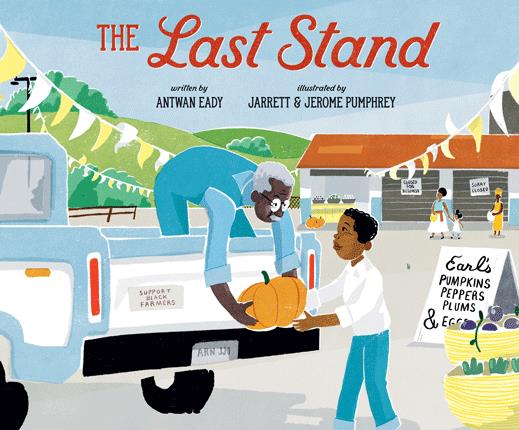| Last stand Author: Eady, Antwan | ||
| Price: $23.78 | ||
Summary:
A little boy is excited to work alongside his Papa as they collect eggs, plums, peppers and pumpkins to sell at their stand in the farmer's market, but when Papa cannot make it to the stand, his community gathers around him, with dishes made of his own produce.
| Illustrator: | Pumphrey, Jerome |
| Pumphrey, Jarrett |
| Accelerated Reader Information: Interest Level: LG Reading Level: 2.50 Points: .5 Quiz: 554952 |
Reviews:
Kirkus Reviews (+) (12/01/24)
School Library Journal (+) (01/26/24)
Booklist (+) (01/01/24)
The Bulletin of the Center for Children's Books (+) (00/12/23)
The Hornbook (00/01/24)
Full Text Reviews:
School Library Journal - 01/26/2024 K-Gr 4—Earl's stand is the last one that's still open at the farmer's market; last year there were two, in other years there were more. A Black child works alongside Papa at this stand, from early till late, with one last stop up Mrs. Brown's driveway with a basket of plums. Papa, with white hair and spectacles, is too tired the following week, but the narrator uses a little ingenuity to make the rounds anyway, and not only are the plums delivered, but he has jam and more as gifts for the elderly man. The plain, childlike narration offers readers a river of information about this work; the pace is fleeting and firm. Using digitally altered, hand-stamped paintings, the Pumphreys create a homespun feeling, but it's no blast from the past. The work in this community feels of the present, the loss of Papa still wounding, even though little Earl is obviously a grown man with a stand of his own by the end. Most readers will have seen these scenes somewhere, and will nestle into some resolve to support farmer's markets and the people whose work nourishes so many. An author's note offers more: that Black farmers once represented 14% of all farming, but lack of access to grants and loans, as well as other forms of soft and hard racism, have brought that number to something less than two percent. VERDICT A self-described love letter, this pairs perfectly with Maria Gianferrari's Thank a Farmer for classroom units or story hours on food and community. —Kimberly Olson Fakih - Copyright 2024 Publishers Weekly, Library Journal and/or School Library Journal used with permission.



